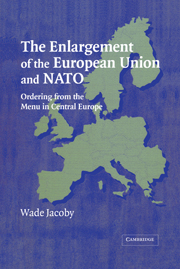Book contents
- Frontmatter
- Contents
- List of Tables, Graph, and Figures
- Preface and Acknowledgments
- Introduction: Ordering from the Menu in Central Europe
- 1 Emulation as Embedded Rationalism
- 2 Emulation as Rapid Modernization: Health Care and Consumer Protection
- 3 Emulation Under Pressure: Regional Policy and Agriculture
- 4 The Struggle for Civilian Control of the Military
- 5 Military Professionalization in War and Peace
- 6 Using Theory to Illuminate the Cases
- 7 Synthesis and Sequence: Juxtaposing Theory Traditions
- 8 Extensions and Conclusions
- Appendix: Selected List of Persons Interviewed
- Works Cited
- Index
3 - Emulation Under Pressure: Regional Policy and Agriculture
Published online by Cambridge University Press: 06 July 2010
- Frontmatter
- Contents
- List of Tables, Graph, and Figures
- Preface and Acknowledgments
- Introduction: Ordering from the Menu in Central Europe
- 1 Emulation as Embedded Rationalism
- 2 Emulation as Rapid Modernization: Health Care and Consumer Protection
- 3 Emulation Under Pressure: Regional Policy and Agriculture
- 4 The Struggle for Civilian Control of the Military
- 5 Military Professionalization in War and Peace
- 6 Using Theory to Illuminate the Cases
- 7 Synthesis and Sequence: Juxtaposing Theory Traditions
- 8 Extensions and Conclusions
- Appendix: Selected List of Persons Interviewed
- Works Cited
- Index
Summary
Each time an expert came to Hungary from a West European country, their influence was immediate, though it differed according to the country they came from. The French wanted us to centralize, then the Portuguese told us to emphasize sectors. Week by week, I could feel who was here.
(Interview with Judit Rózsa, Hungarian regional policy official)The majority of the EU's political influence comes through its ability to regulate the behavior of states and firms. Unlike national governments, it has relatively small fiscal resources that amount to just over 1% of the GDP of the EU countries. That said, the EU does have two large pots of money, and they are the subject of this chapter. The largest is also one of the oldest of all the European integration projects, the CAP. Between 2000 and 2006, agricultural spending will average 42.5 billion euros per year (in 1999 prices), of which about 38 billion will fall under the CAP and the other 4.5 billion in rural development programs. About 35 euros out of every 100 earned by EU farmers comes in some form of aid financed by taxpayers or consumers. The second pot is almost as large, though it is not nearly as old. The EU Structural and Cohesion Funds, often referred to collectively as the structural funds, will receive over the same period about 30.4 billion euros annually.
- Type
- Chapter
- Information
- The Enlargement of the European Union and NATOOrdering from the Menu in Central Europe, pp. 77 - 115Publisher: Cambridge University PressPrint publication year: 2004



